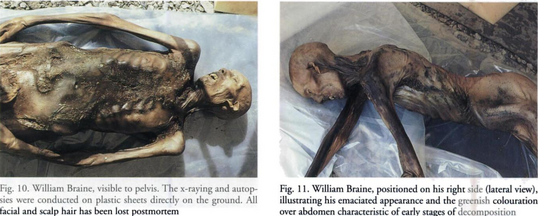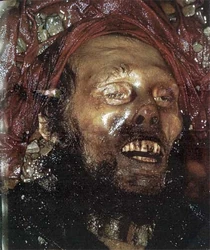William Braine was a British explorer and Private of the Royal Marines, born in 1814. He was a crewman in Rear-Admiral Sir John Franklin's last expedition, that sailed from England in 1845 to locate and map the uncharted area of the Northwest Passage through the Canadian Arctic, with two vessels and 129 men. Now termed as "Franklin's Lost Expedition", the voyage ended in tragedy as the crews of both ships —HMS Erebus, the flagship, and HMS Terror— succumbed to the harsh conditions of the Arctic circle. During the first winter alone, in 1846, three men died under non-specified circumstances: John Hartnell, John Torrington, and William Braine, who were buried on Beechey Island, where the expedition's camp was located.
Despite this setback, the team followed on with their objective until they found themselves stuck in the ice near King William Island, in September 12, 1846, where they spent more than a year until the ships were abandoned in April 1848, as written by Erebus's Captain James Fitzjames on a note later recovered. By then, the death toll was of 9 officers and 15 men, and the decision to walk more than 400 km (250 mi) and across approximately 100 miles of sea ice towards the Canadian mainland, while dragging a 1,200-pound lifeboat, took the lives of the remaining explorers, still far away from any form of civilisation. The Royal Navy officially declared them officially deceased in service on 31 March 1854, and according to Inuits who aided the subsequent search parties, the desperate crew might have resorted to cannibalism on their last days, which was endorsed by archaeological research from 1981.
Their remains were eventually found by one of the search parties, who uncovered the small graveyard on Beechey Island where John Torrington, John Hartnell, and William Braine had been buried, and mostly left undisturbed due to the difficulty in accessing the frozen coffins. A fourth man named Thomas Morgan, part of this search party, was then buried alongside them after seemingly dying of scurvy, but his body was never exhumed.
In 1984, the body of John Torrington, the first crewman to die, was exhumed and autopsied by Dr. Owen Beattie, a professor of anthropology at the University of Alberta, and his team, attracting worldwide attention for their speculations on the explorer's cause of death —that included pneumonia, scurvy, lead poisoning, starvation and tuberculosis. Hartnell and Braine’s bodies later received the same treatment, and were the subject of many research papers, books, TV shows and even a PBS Nova Documentary titled ‘Buried in Ice.’
Mummification[]
The bodies of the three men were in fine condition due to the freezing temperatures. Each of them had wooden coffins (with copper plaques containing names and other personal data on the lids), clothes, toenails, hair, beards and eyebrows relatively well preserved. They were found under 6 feet of permafrost and were, together with everything else, frozen in solid blocks of ice, which required careful thawing with buckets of warm water.

Replica of Braine's grave marker at Beechey Island (Ray Sanford, 2003)
Braine's face was covered by a red handkerchief and showed a gaping mouth, retracted lips and half-opened, poorly-preserved eyes. The research team noted that his burial was hasty, as his arms, body and head were not positioned carefully in the coffin, one of his undershirts had been put on backwards, and the coffin itself seemed too small for him; its lid had pressed down on his nose, leaving it flattened and upturned. He was also, like the other two, seriously underweight at the time of death.
Researchers believe that Braine's body was left on board HMS Erebus for a while before he was buried, as it showed signs of decomposition (a typical green hue to the abdomen), and appears to have been gnawed by rats, with teeth marks on his shoulders and other parts of the body. His left arm had been severed, presumably postmortem, and seemed to be missing, but was later found positioned underneath his corpse. In handling the body for analysis, the researchers discovered it to be malleable instead of stiff.
In his grave marker is the following inscription:
SACRED TO THE MEMORY OF WILLIAM BRAINE, R. M.; H. M. S. EREBUS; DIED APRIL 30, 1846, AGED 32 YEARS; 'CHOOSE YE THIS DAY WHOM YE WILL SERVE,' JOSHUA, CH. XX1V., 15.
Studies[]
The bodies of the Beechey Island men were studied extensively from 1981 onward, and through analysis of their hair and nails, it was revealed that all three showed high levels of lead in their system. At first, it was believed that the lead had come from the crude soldering on the expedition's food cans, but scientists now believe that the lead came from the water filtration system on the ship. This has not being proven yet, as the ships have yet to intensely studied after the rediscovery of The HMS Erebus in 2014.
Under difficult field conditions, Derek Notman, radiologist and medical doctor from the University of Minnesota, and radiology technician Larry Anderson took many X-rays of the crewmen prior to autopsy with a portable unit. Barbara Schweger, an Arctic clothing specialist, and Roger Amy, a pathologist, assisted in the investigation. Sampling of tissue from Braine’s ribs was also taken during the necropsy.

Photos of William Braine's mummy during its autopsy, in 1981
Pathology[]
The autopsies of all three men revealed them to be critically underweight, with the presence of calcified granulomas —small masses of tissue that are formed in response to infections such as tuberculosis— in their lungs. For William Braine, a granuloma was found to contain ‘acid-fast bacteria,’ a common type of bacteria found in soil and water, with Mycobacterium tuberculosis, the main cause of the disease, being one of them. Tissue samples were analysed, but the presence of M. tuberculosis was not confirmed.
However, together with the weight loss prior to death, other radiological findings reinforced the tuberculosis claim: radiographic analyses prior to the autopsy revealed a slight kyphosis (abnormal curvature) and other defects in Braine’s spine, which suggests a condition called Pott's disease, itself a result of chronic tuberculosis infection. It is unlikely that those spinal conditions were caused by syphilis or old trauma, and there were no signs of dietary deficiencies such as scurvy.
Upon testing of tissue, blood, hair and nail samples, it was noted that the three sailors showed a very high presence of lead in their systems. Braine, the last to die, showed 220 parts per million (ppm) in his hair, which is over one hundred times the acceptable level. However, food tins containing lead were very common for the time, so the strongest hypothesis lead back to the ships' one-of-a-kind desalination rig, with lead pipes in which hot water would flow, carrying a far larger amount of the metal than it would at room-temperature.
So far, the cause of death is not officially concluded, as there was no concrete, definitive evidence to suggest it in any of the men, but tuberculosis, lead poisoning, starvation and pneumonia (or an association of them) weren’t entirely ruled out.
External Links[]
☀ Futurism: What Can We Learn From the Well-Preserved "Franklin Expedition" Mummies?
☀ A Case Study: Was Private William Braine of the 1845 Franklin Expedition a Victim of Tuberculosis?
☀ Franklin Expedition - The mystery of a tragic search for a Northwest Passage
☀ Find a Grave: WIlliam Braine
☀ https://news.nationalgeographic.com/2017/04/franklin-expedition-ship-watson-ice-ghosts/
